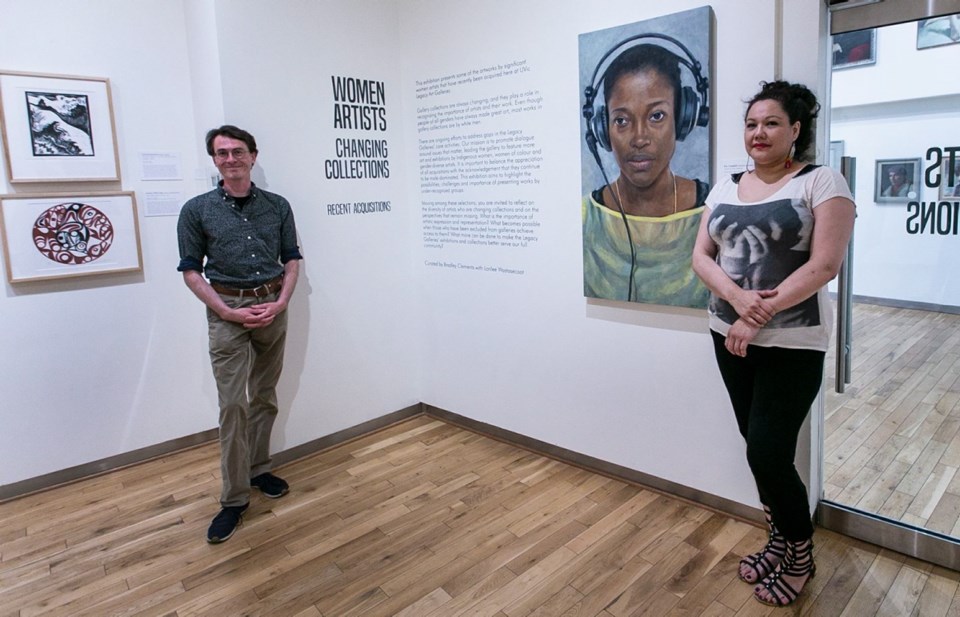In putting together an exhibit featuring artworks by women, the first challenge for curators was finding pieces amid Legacy Art Gallery’s male-dominated collection.
That lack of representation in the arts is exactly what Bradley Clements and Lorilee Wastasecoot are trying to address with the exhibit showing at the gallery, at 630 Yates St in Victoria.
“We’re trained that when we go into a gallery we’re going to see the works of white men, and that too often goes unquestioned,” Clements said.
The exhibit, Women Artists Changing Collections: Recent Acquisitions, on display until July 20, showcases works acquired by the gallery within the past five or six years.
Art created by women receives significantly less exposure than the works of men, according to a review on the status of women in the arts prepared for the Ontario Arts Council last August.
Researchers from the University of Montreal and two Australian universities found that the lack of exposure for art by women indicates they face “a gender-based disadvantage” in the industry. The review concluded that art reflects and shapes the social world, and that gender inequality in the arts is an issue of cultural significance.
“What good is it if we’re all exposed to the same things over and over again?” Wastasecoot said. “Everyone wants to see themselves in these spaces. It’s important to keep pushing ourselves to do better — to represent all groups. If we’re not doing that, we should be asking ourselves why.”
Because most of the gallery’s pieces come as donations from private collectors, Clements said, the collection reflects what the art community has deemed worth collecting. He and Wastasecoot discovered that every piece they selected for display was donated by a woman. One piece was given to the gallery by a woman and her husband.
The gallery has a small budget to purchase pieces, and it has used that money to acquire art by Indigenous women, said Caroline Riedel, curator of collections at the University of Victoria’s Legacy Art Galleries.Clements said it’s harder for women to be recognized as artists because their work tends not to be as collected as that of men.
“If you can’t be recognized in these spaces where we come to see each other’s humanity, like in art galleries, maybe we start to see each other as less than human,” he said. “This is something that changes how you think about collections and how you think about these artists.”
The curators have already seen the effect the exhibit can have on visitors. After seeing the exhibit, a couple who owned a piece by Kwakwaka’wakw artist Ellen Neel decided to return it to her granddaughter, Lou-ann Neel. Both women have pieces in the exhibit. In a description of her work, Lou-ann says she is disappointed by the lack of efforts to address the appropriation of Indigenous art. It was “a true treasure to hold works with grandmother’s energies,” Lou-ann wrote in a Facebook post after receiving her grandmother’s carving.
“That alone vindicates this for me,” Clements said.
Legacy Art Gallery has committed to addressing the lack of diverse representation in its exhibits. This year, the gallery’s feature exhibitions are all works by women. The gallery is currently showing a collection of pieces by Myfanwy Pavelic, a Victoria-born and mostly self-taught artist.
This year, Wastasecoot will open a basketry exhibit of Indigenous female artists. In putting the collection together, Wastasecoot has discovered that the names of the women who created the baskets were rarely recorded.
“It’s likely because they were Indigenous women, and basketry was seen as a craft, not an art,” Wastasecoot said.
Wastasecoot has been working to identify the artists by contacting Indigenous curators and people involved in the basket-weaving community on the Island.
In putting this exhibit together, Clements said he realized that its impact will be lasting. “Lorilee’s work is changing the way we understand these baskets in our collection, recognizing these people who weren’t recognized before. That’s going to have ongoing ripples,” he said.
“The ripple from this exhibition is everyone questioning who we are representing in art.”



